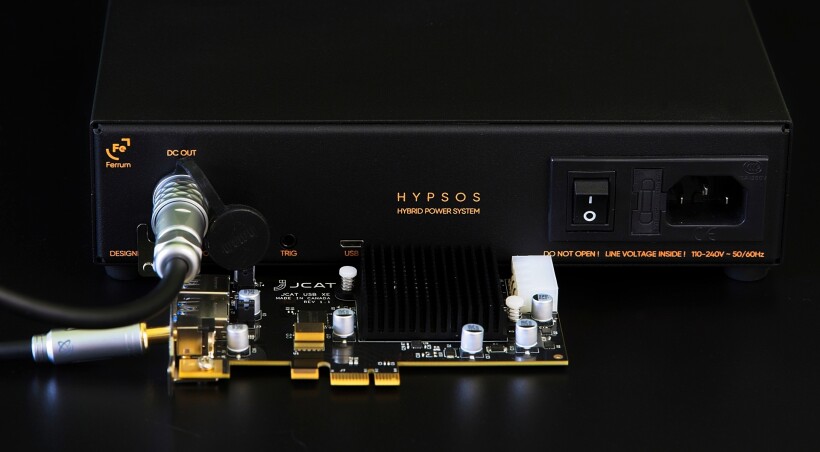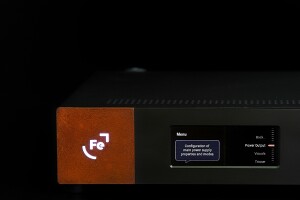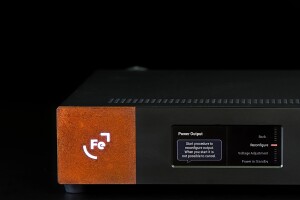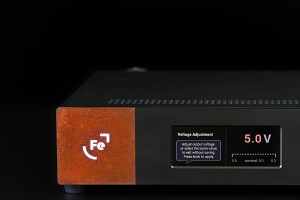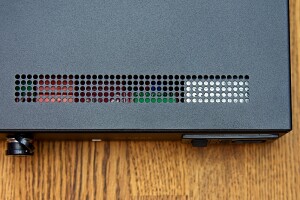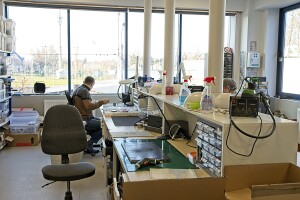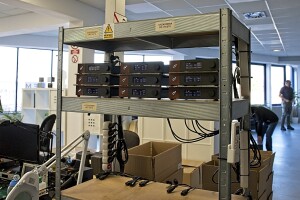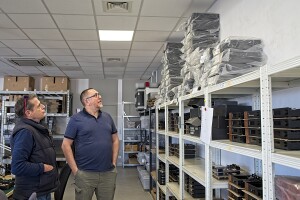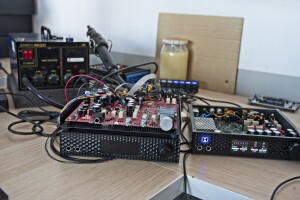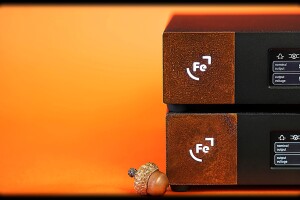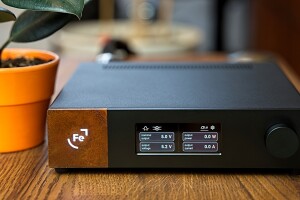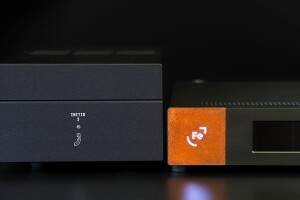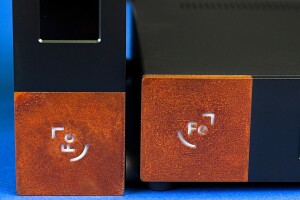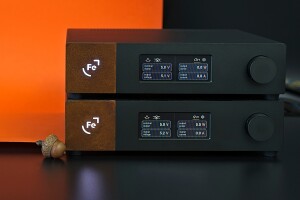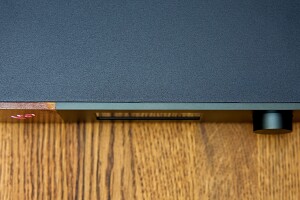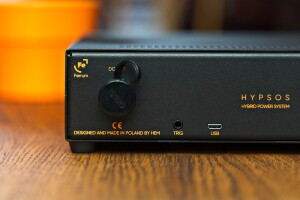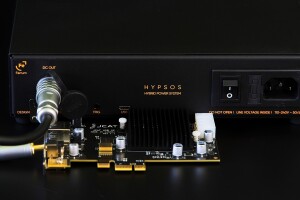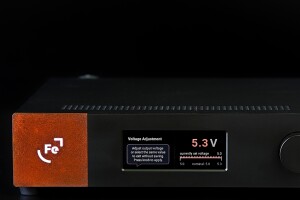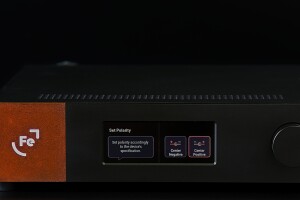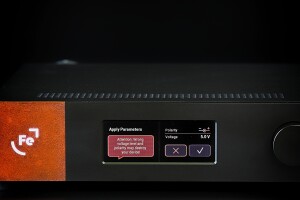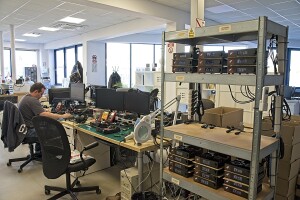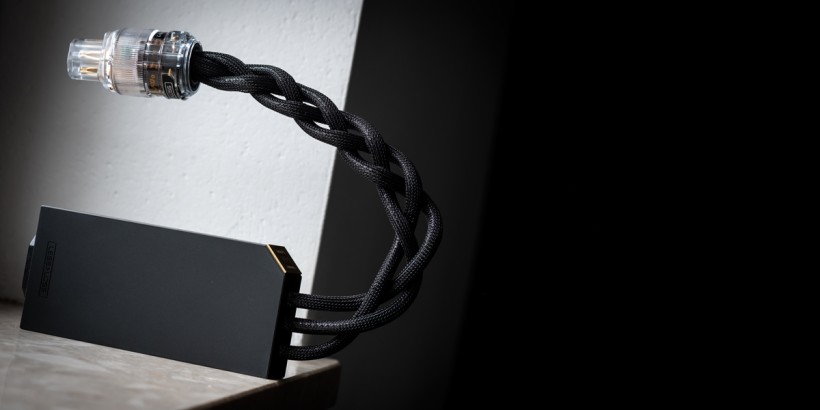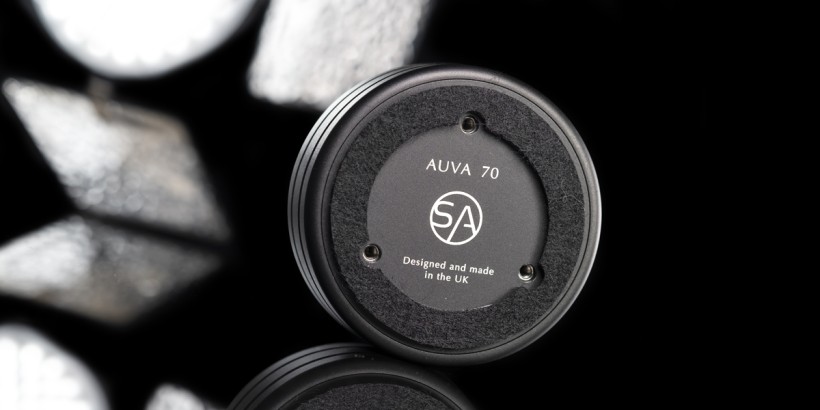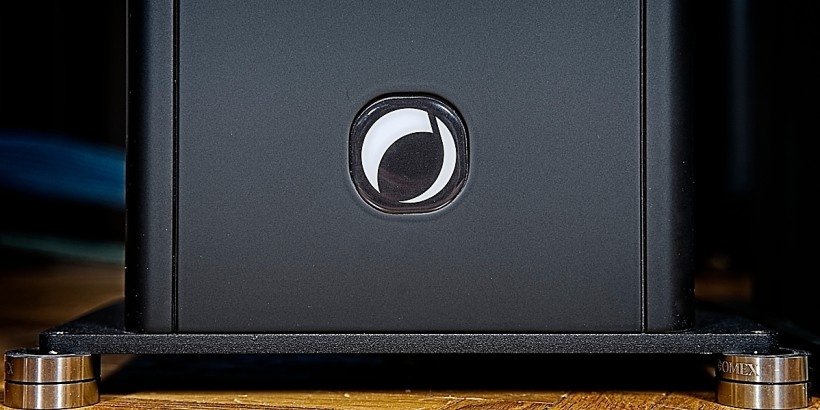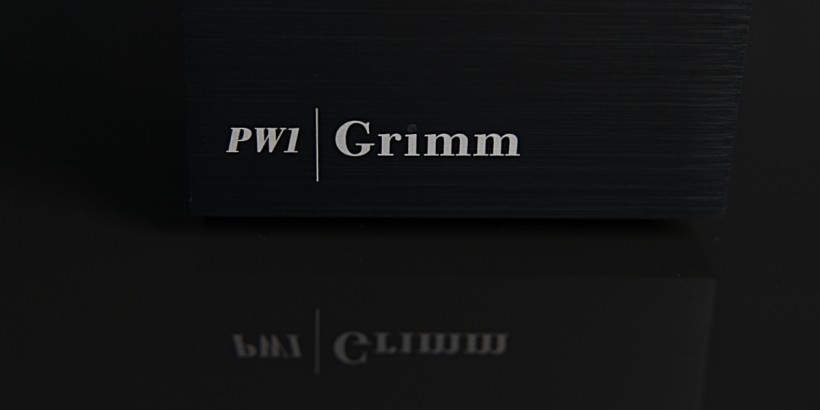It’s been a while since audio files became a widely used carrier of music. To make the best use of them, manufacturers had to develop proper solutions, design D/A Converters, streamers, switches, digital cables, and so on. The last piece of the puzzle, same as for analog components, is a high quality power supply. We are testing one of the most interesting and versatile ones available on the market today – the FERRUM HYPSOS hybrid power supply.
Introduction
The manufacturer of the reviewed product is a renowned company with over 20 years of experience on the market, called HEM. Until recently it was known for its role in the development and manufacturing of MYTEK products. A while ago, though, they introduced their brand, Ferrum Audio, for a growing lineup of components developed in-house by a team of talented, young engineers. The first one, that has already made some noise on the market, is the one we got for this review, the Ferrum HYPSOS power supply. Quite recently, another product was introduced, the OOR headphone amplifier. For now, let’s focus on the former.
An idea for an after-market power supply that could be used together with components sold by other brands is not a new one. As I’ve already mentioned, a quality power supply is a key element of any high-end audio system hence many companies developed their custom products to satisfy growing demand. What’s different about Ferrum’s approach is twofold. For one, most such power supplies are linear designs. By design, there are supposed to replace either build-in or external original power supplies of lesser quality, usually of a switching mode type. It’s just that, as with many other solutions and technologies used in audio, also the issue of power supply is a bit ambiguous. On the one hand, it is the linear power supplies that are most often suggested as potential upgrades for numerous components. On the other hand, there are audio brands, even considered top high-end ones, such as, for example, Soulution, that use SMPSs in their high-end products not to cut the costs, but because they consider such solutions beneficial for sound quality. 
A team of Ferrum engineers recognized the advantages of both of these solutions. They ultimately came up with the HYPSOS, a power supply that stands out among others with it hybrid design – in part linear and part switching mode. The idea was to utilize qualities of both solutions, eliminate their downsides and ultimately achieve an optimal result. The other most important feature differentiating HYPSOS from its competitors is its versatility. It is indeed capable of powering only one device at the time (although, as I learned when visiting the company recently, FERRUM is currently working on some sort of a splitter, that will allow using HYPSOS to power two devices simultaneously, as long as they both require the same voltage and their combined power requirements don’t exceed its maximum current output capabilities), but it allows user to adjust the output for a particular device and to change DC plug’s polarity.
The range of DC voltage the HYPSOS can provide is quite impressive – one can use it with any device requiring voltage between 5 and 30 V. As some of you surely know, a required polarity of a plug for particular device, may differ, but is not a problem for HYPSOS users, as they can choose correct one in device’s menu. That’s still not all. HYPSOS offers a fine-tuning of voltage (function called Sweet Spot Tuning or SST) delivered to a powered device with precision down to a 0,1 V. Say you use a device that requires 12 V DC – with FERRUM power supply you can easily try, whether the 12 V is an optimal value, or maybe 12,1 or 11,9 V will offer better sonic results. That’s a feature many audio enthusiasts will welcome as they (I should say we) love to fine-tune their systems to achieve the best possible performance. As you can already see, the FERRUM HYPSOS is quite a special device.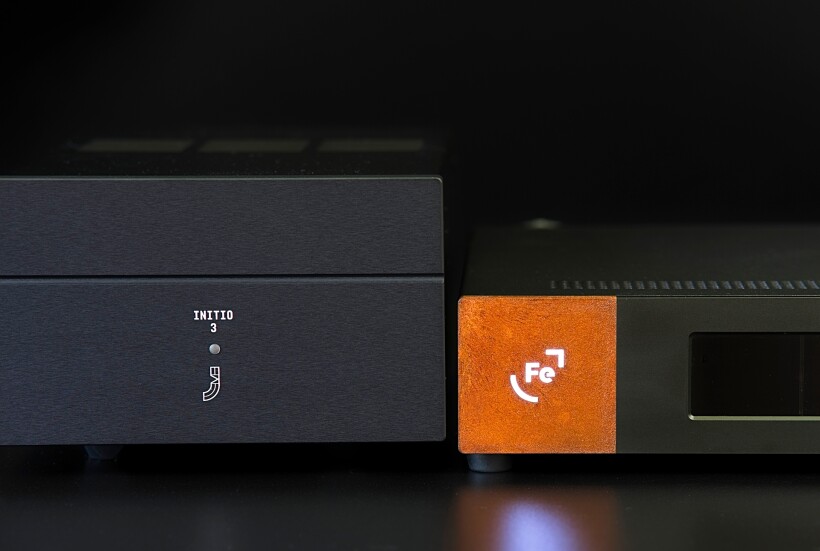
Design and features
Ferrum HYPSOS is an external DC power supply, whose job is to replace a build-in or original external PS for one of many audio components that require a direct current not exceeding HYPSOS’ specifications. The manufacturer specifies that it is capable of supplying a DC within the 5 to 30V range for devices requiring no more than 80W of power (for voltages over 13,3V). This Polish power supply is a hybrid design, partially linear, partially switching mode, which allowed its designers to combine qualities of both solutions. The device sports a relatively small (218 x 50 x 207mm) rigid chassis made of thick, metal sheets painted black. The front of the device features an intriguing, eye-catching element made of the so-called Corten (or Weathering) steel, that after several years of exposure to weather conditions forms a rust-like appearance. The idea for such an exotic decorative element came from the fact that in the area where the HEM currently has its headquarters, the remains of smoke chambers and smelted lumps of iron were discovered. It is also in this element of the front of the device that the company logo, illuminated in white, and therefore strongly contrasting, has been incorporated. The rest (most of the front) was made of aluminum.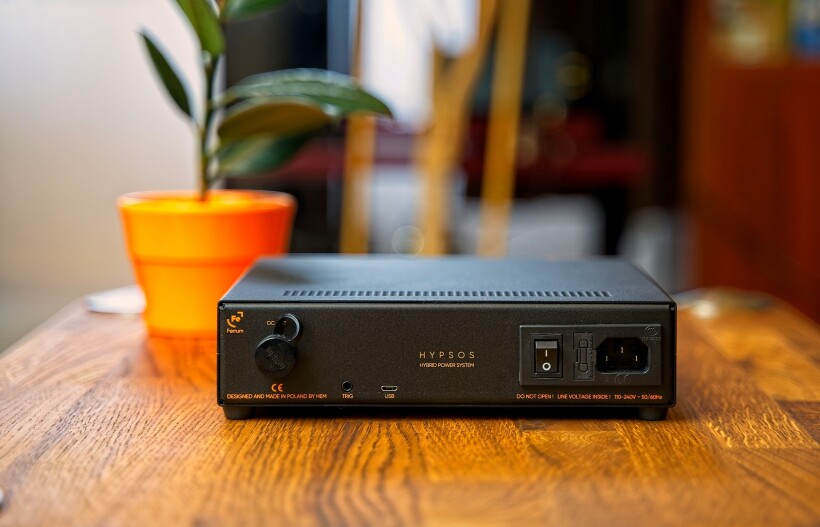
A color display is placed centrally on the front panel, and settings in the device’s menu allow you to select its brightness and whether or not, and if so after what time, it fades out. The same applies to the already mentioned backlit logo. When turning the HYPSOS on for the first time, with the help of the display and a rotary knob located next to it, user either selects a specific device model HYPSOS is to be paired with from a factory-programmed list, which automatically sets the appropriate parameters for said component, or chooses manually specific settings (voltage and polarity of the DC plug). The list of models with proper settings available in HYPSOS’s menu grows with each firmware update, but it was already quite impressive when I reviewed it with dozens of popular models of various brands. In the menu, you can always check the currently installed firmware version, then check the company’s website for the latest one, and if a new one is available download and install it using a mini-USB port on the rear panel. While the device is in use the display shows the currently selected nominal and actual DC voltage, and the current used by the powered device (in Watts and Amperes).
On the back panel of the HYPSOS you will find an IEC power inlet, the main switch, as well as a DC output, and the aforementioned USB port. The DC output features 4 pins, two of which are used for feedback allowing the device to deliver flat voltage all the time. An interesting addition is a plastic plug, which protects the power outlet during transport and periods of non-use (provided that the DC cable is not connected). A fairly short (50 cm) DC cable terminated with a 5 × 2.5 or 5 × 2.1 mm plug is included. It is possible to order HYPSOS with a custom cable if a different termination or length are required. When I visited Ferrum, I discussed the matter of the length of the cable, which turned out to be insufficient from my point of view, with Mr. Marcin Hamerla, the head of the company. As he explained, the standard one supplied with HYPSOS is short not to cut some costs, but because every DC cable should be as short as possible to perform at its best. Obviously, in cases where a longer cable is required, the manufacturer can provide one upon order.
Sound
HYPSOS vs INITIO 3
The HYPSOS review coincided with another one of the whole set of also Polish, computer-audio-related brand, the JCAT. So while, when requesting FERRUM for this review, my primary assumption was to test it against KECES P8 (mono) powering my server (requiring 19V), the JCAT NET XE and USB XE cards plus the brand’s own INITIO 3 linear power supply (see the test HERE) offered another opportunity to perform an additional test (which turned out to be a very lucky coincident, indeed, as you are about to learn). I am going to start the review with this last part, as that’s how I started my assessment, and later I will move to comparison against the KECES P8 while powering my custom music server. For this part of the test I used mostly the NET XE card, and to a lesser extent, the USB XE, both of them requiring 5V (DC).
The Ferrum HYPSOS, as I’ve already mentioned, can deliver a large range of output voltages (from 5 to 30 V). Additionally, its current efficiency is quite high, so one can pair it with a wide range of products, including some digital-to-analog converters, phono preamplifiers, music servers, headphone amplifiers, USB converters, etc. Matching HYPSOS output parameters to any specific product is very simple particularly if you find its name in the HYPSOS’ supported models menu. If that’s the case all you need to do is highlight the name and confirm the selection. The power supply will set the appropriate parameters for the DC output automatically. If, however, you can’t find your component on the supported models list (as I didn’t find the JCAT cards) you need to select proper parameters manually. When the HYPSOS is first turned on it will start a configuration process and with the help of the display and the knob located next to it you will easily choose the required voltage and polarization of the DC plug. To do that you need to know the requirements of the device you want to pair with the Ferrum. You will find such information in the user manual of said component, and one thing to remember is, that current and voltage requirements can not exceed the maximum capabilities of HYPSOS.
For the JCAT cards, I needed 5V and a positive (+) central pin, as is the case with most devices (that I know of), but you should always check if that’s true also for yours. The HYPSOS makes sure (by displaying an appropriate message on the display) that the given parameters are correct, warning that entering the wrong ones may damage the powered device. After confirmation, the Ferrum delivers the set voltage to the output and through the DC power cable to the connected device. I’ve mentioned already, that the 50cm long cable was a bit too short for me, as it did not allow me to place the HYPSOS away from the server but rather on top of it, which was less than ideal. You want to place the Ferrum in such a way, as to display its original, attractive appeal, but to avoid any noise cross-contamination it should be placed at some distance from powered component and such a short DC cable may in some cases make it difficult. The solution is simple – order a longer cable, but only as long as necessary to avoid degrading the performance. I had to put the HYPSOS directly on the server, which apart from potential noise pollution, was not ideal, as the server is a passive device with its chassis acting as a radiator. The tested power supply also gets a bit (not much, but still) warm so it I wanted to avoid any direct contact between these two. Ultimately I ended up using four wooden feet with a small footprint between the two components. 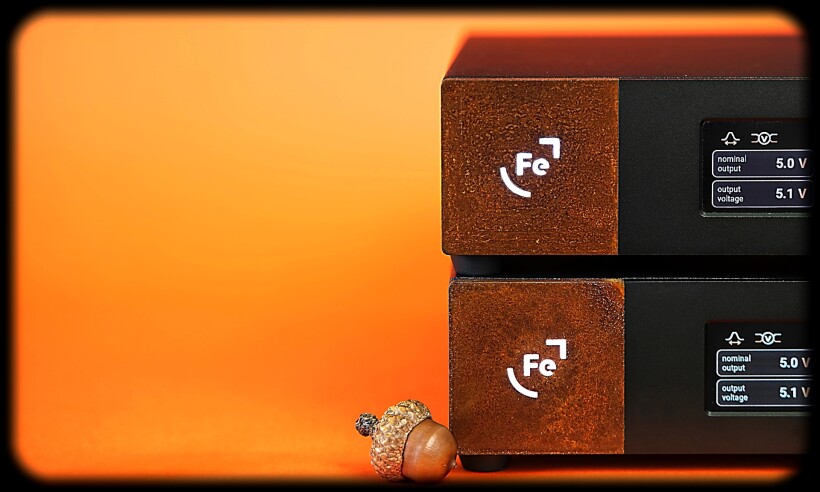
All right, to the point. Music servers, especially those that some users (including yours truly) assembly themselves, are highly susceptible to various upgrades. One of the most important ones is a high quality power supply. Having such a custom server one can often use several separate power supplies, one for the entire server, another for a hard drive, USB and/or LAN (NET) cards, as well as for other devices operating in its environment (including network devices such as switch, router, or NAS). To be honest, up to this point it was pretty clear to me that an introduction of each linear power supply (for the server, the USB card, NAS, and the switch) offered noticeable, indisputably positive effects, which only differed in scale, as the character was usually quite similar. I also treated the switched-mode power supplies as “pure evil” as in each of the above-mentioned cases I’d replaced one (though “standard” issue, not an audiophile-grade) with linear PS, and in each case, it “cleaned” the sound (or at least lowered the level of) from noise, distortions, which translated into a better performance. Improvements included timbre and dynamics differentiation, resolution, clarity, and transparency of the sound, its smoothness and fluidity. A replacement of a standard power supply with a linear one in each of the above-mentioned cases in my system resulted in a more natural, thus more enjoyable experience.
The FERRUM Audio product is unique in that it combines these two worlds, i.e. of linear and switching mode power supplies, trying to benefit from the advantages of both. The idea of bridging two seemingly different or even opposing technologies is not a new one in the audio industry. Hybrid amplifiers using both, transistors and tubes are a good example, as well as cables combining, for example, silver and copper conductors. As far as I know though, Ferrum Audio is the pioneer in combining switching mode with linear power supplies. Manufacturers who use switching power supplies even in some high-end components claim, that linear ones limit dynamic range, that they are not able to produce large impulses fast enough, that they limit the energy of the sound, which translates to inferior performance. From my experience, I can say that this is true to some (small) extent, but whenever I used some (high quality) linear power supply instead of an SMPS, the sound got richer, better weighted, more detailed, more colorful, purer, and even more expressive to my ear. Also, it always got more resolving. So it seems to me that it is not even about which version (of power supply) is better, as both have pros and cons. The choice in most cases is based on individual preferences in a given system. After all, in audio, the quid pro quo principle has been known for a long time and it works in most cases – we achieve some improvement in the performance (by introducing some new/better components), but it almost always comes at some cost. So what we choose between, are in fact the pros and cons of each solution and whenever a sum of the former outweighs the latter, we accept the outcome as an improvement. How does the Ferrum Audio’s idea fare in the real world?
The JCAT NET XE card needs to be fed with a 5V DC, but unlike most similar components, it is a bit more power-hungry. Most DC 5V power supplies offer a maximum current of 1A, while this card, according to the manufacturer, needs a minimum of 1.5A. JCAT offers their own high-class linear power supplies that satisfy the requirements of those cards, and in this part of the test, I treated the FERRUM HYPSOS as an alternative to the cheaper one of JCAT’s two, the INITIO 3. The differences between the sound with the JCAT NEXT XE powered by the (hybrid) HYPSOS and the (linear) INITIO 3 turned out to be easy to point out (which does not mean that they were huge). The influence of these two power supplies on the sound is similar in terms of the scale and the resulting quality of the sound, but at the same time different enough in terms of the nature of the sound, so that potential buyers should be able to make an easy choice between the two. Having said that I have to admit, I had a problem when it came to choosing a preferred option in this particular application. I was wondering whether to choose a philosophy that I had been following for some time, i.e. of using as neutral, pure sounding source as possible (and letting the amplifier decide the actual sonic character of the sound coming from speakers), or to give in to my personal preferences, in which the sound doesn’t have to be perfectly neutral, but it needs to be as natural, hence as enjoyable as possible.
The FERRUM HYPSOS power supply is primarily about speed, dynamics, transparency, delivering a highly detailed, resolving sound (this is a simplified expression – what I mean is how the tested product affected the sound, not how it sounded itself). The sound with the tested device was exceptionally pure and open, which at first seemed like a slight brightening. However, this was only an impression resulting from comparing the sound to what, in this particular case, the JCAT NET XE card offered while used with the INITIO 3. The latter focused a bit more on the richness and proper weight of the sound, its smoothness (confirming this way what I’d written about the expected advantages of linear power supplies). Where the HYPSOS perfectly differentiated sounds, with a clearly marked leading edge and a lightning-fast attack, the INITIO 3 softened it gently, emphasizing and adding weight rather to the sustain not attack phase. Interestingly, the decay with both power supplies was equally long and full, and yet not the same. With the HYPSOS it seemed to be a bit airier (for lack of a better word), lighter, more delicate, and with the INITIO 3 a bit more weighted, with a bit more body to it. These were by no means big differences, but ones that could have been pointed out even without much of an effort.
With the HYPSOS I particularly enjoyed all the recordings with metal percussion instruments, with their exceptional crispness and beautiful decay, fantastic differentiation (which was even clearer whenever the drummer used brushes), and the aforementioned clear, fast leading edge that all played a huge role in stunning realism of the presentation. Those long, slightly airy, but not fading out too early decays or long reverberation in such recordings made in large venues (most often churches) with FERRUM turned into truly immersive spectacles with a scale that by far exceeded the size of my listening room. The soundstage was rendered a bit differently by each of these two competitors. The FERRUM offered an impressive depth, while the JCAT delivered a slightly wider sound panorama. There were also some differences in terms of imaging, but rather in the means used than results as those were equally convincing in both cases. The protagonist of this test precisely located each of the large phantom images on the stage and presented the proper size and three-dimensional bodies using high precision to draw each of them. The competitor was a bit less precise in terms of contours, but the images were better filled and more weighted in, they had “more body”, and therefore were equally present.
So which power supply was better than? In this particular case, i.e. when they both powered the JCAT NET XE card (in my system!), I rated both devices as equally excellent performers. I believe that the choice between them would in most cases be decided by other components in a particular setup and the user’s expectations and preferences. In systems that are overall denser, warmer sounding, HYPSOS could contribute a necessary precision, transparency, and the ability to extract more tiny information from the background. On the other hand, in systems that lack a bit in terms of richness, that sound bit too bright, that need more weight to the sound, the INITIO 3 could do a better job. In my case, with the LampizatOr Pacific tube DAC and the A-class solid-state integrated, the GrandiNote Shinai, the choice should have been easy, but it wasn’t. It is a well-balanced system and even details (yes, I consider them details compared to the main components) such as cables play quite an important role. With my own Hijiri Kiwami interconnect and LessLoss speaker cable, but also with the IC and speaker cables from the top Marohei Statement series (test HERE), i.e. cables on the slightly warmer, richer side of the spectrum, HYPSOS was the preferred choice. However, with the set of Statements (IC + speaker + power cables) from the TelluriumQ, i.e. cables that, like the FERRUM itself, are highly transparent, precise, detailed, even analytical (in a good sense of the word) I preferred INITIO 3. I would like to emphasize once more that the choice in my case was a matter of nothing more but individual preferences because both, the Ferrum HYPSOS and JCAT INITIO 3 did a remarkable job.
HYPSOS vs KECES P8 (mono)
In the second part of the test, I challenged HYPSOS a bit more. Instead of „easy” 5 V now it had to deliver 19,3 V to my much more power-hungry custom server. It is a passive device, with a single SSD for the operating system and Roon core, but it was built several years ago and features quite a power-hungry, 4-core Intel i5 CPU. Its TDP is 95 W which, on paper, exceeds HYPSOS’ capabilities, so I would have been hesitant to use Ferrum this way was it not for the fact, that a display of the power supply I had been using, KECES P8 (mono), provided me with data of actual current consumption. When playing music my server used less than 1 A, when shutting down the consumption peaked momentarily to a maximum of 2,8 A. In other words, it seemed perfectly safe to replace KECES with HYPSOS and compare the two. Let me add that I had to use an additional adapter as my server required a larger diameter plug.
This part of the test took me much less time than the other ones. Why? Compared to the Keces P8, the HYPSOS’ impact on the sound was similar to that of it powering the JCAT cards. Precision, purity, and transparency of the sound were its basic advantages. It’s only that, as I’ve mentioned many times in my reviews, building an audio system is a bit like putting together a jigsaw puzzle. All elements have to fit together perfectly to achieve the desired sonic effects. Mind you, I’d spent years working on my setup, finding those pieces of the puzzle that fitted in best. And so the KECES had been selected at some point as it added more richness and weight to the sound, and in this particular application, meaning powering the entire server, it had been exactly what I’d needed. The Ferrum fitted better into the whole concept when powering the NET XE (or USB) JCAT card, where its undoubted advantages contributed more effectively to the entire intricate structure of my system. Someone else in my position could have made the opposite choice, and for them, it would have been just as right one. You could also look at it from the purely practical viewpoint, or in other words – consider the costs. Among these two devices, HYPSOS is the more expensive one, so if you can afford just one, you should use it where its impact on the sound is, maybe not the greatest, but the most desirable, pushing the performance in a required direction. So for me, it was the KECES for the server and the Ferrum HYPSOS for (alternatively) NET/USB cards.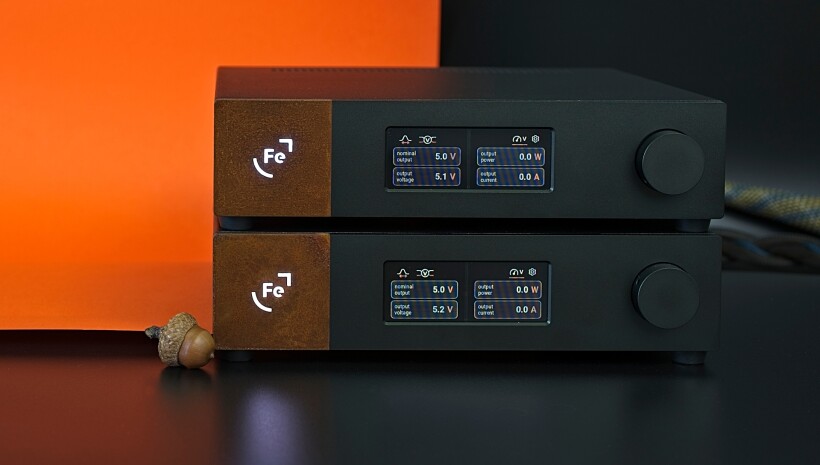
HYPSOS vs HYPSOS Signature
After a few weeks of using and comparing all these components, to spicy things up, another FERRUM HYPSOS, this time an upgraded version called Signature, was delivered to my place. This version is offered by one of the Ferrum distributors, Metrum Lab, who used their proprietary IFE technology to further improve HYPSOS’ performance. Some of our readers may remember my review of the ESA Credo Stone loudspeakers from a few years ago, which was a special version of the highly acclaimed ESA Credo model modified using an alternative, unique composite material for their cabinets and with their internal cabling and several elements of the crossover treated using the IFE technology. Admittedly, the project was ultimately abandoned by ESA, but only because the unique composite material used for the cabinets turned out to be too difficult to process on larger scale, and therefore too expensive. Nevertheless, the Metrum Lab technology worked so well, that first it was used to upgrade the entire home system of Mr. Andrzej Zawada (ESA’s boss and chief designer), and then they started to offer it as an upgrade for the brand’s loudspeakers to all customers, new and existing ones. ESA might have been one of the first companies benefiting from IFE, but currently, there are several more of them. Some of them openly admit it, others prefer to keep the use of IFE a secret.
Same technology had been used for HYPSOS. To be clear, the upgrade offered by the Metrum Lab had been approved by FERRUM, as the two companies had been cooperating already for some time. Currently the standard version is sold by the manufacturer and its dealers (including Metrum Lab), but the Signature version, so one upgraded using IFE tech, at least for now, is sold only by the Metrum Lab. The upgraded version costs more, so part of my job was to assess whether spending an additional 400 EUR (at the time of the review) was worth it. Let me once more emphasize that the original and Signature versions are in fact the same devices, no components are replaced, they also look identical. The Metrum Lab’s upgrade is based on subjecting some components used in HYPSOS to the IFE which, based on experience with the ESA Credo Stone I had to consider an upgrade further enhancing Ferrum power supply’s already remarkable value. I was given the task of comparing two devices that (almost) did not differ in any other way than the usage of the IFE on one of them. Almost, because Andrzej Grochowski, head of the Metrum Lab, together with the Signature delivered also a DC cable made by his company and treated with IFE. Its (technology’s) use in audio cables had been thoroughly tested in Metrum Lab’s own cables. As I have already started my assessment of the brand’s top line cables from the Edge Series, so let me suggest to those, who always look for interesting options in the high-end sector of the audio cables market, to check these out, as they are indeed, very special. I also talked to Mr. Andrzej about IFE and his products so even before the pending review of the Edge cables you will have a chance to read whatever he revealed (which was not much, but still better than nothing) regarding his proprietary technology.
A few photos from a recent visit to Ferrum Audio – the crew is really busy doing their best to fullfil orders
For this part of the test I prepared a separate playlist in Roon with tracks representing various musical genres, studio and live recordings, plugged and unplugged, some with vocals, but all of them of a very good quality. I made comparisons both head-to-head (as far as it was possible), i.e. stopping the playback and switching now and then between the power supplies (supplying the JCAT NET XE card), but also listening to both separately over longer periods. During the latter (although chronologically first) stage of comparisons, when I had a chance to get used to each version of HYPSOS separately, the differences seemed to me rather small, maybe not insignificant, but small. To be precise, right after switching from one to the other, it seemed to me that there were clear differences, but the longer I listened to any current one, the more those blurred. The basic conclusion from these auditions was that it was an excellent power supply, whether modified or not. The sound was fast, dynamic, transparent, highly resolving, well-balanced, coherent – in short, I didn’t see any downsides but only upsides of using any of them. The second conclusion, pending further verification, was: perhaps the differences were so small that they didn’t matter. Our hearing tends to adjust quite quickly to what we hear, so maybe listening to shorter fragments quickly switching power supplies would have a better chance to give me an answer whether there were any actual differences and how important they were. It is worth noting here that during these listening sessions I had no idea what the difference in price between the versions was – I asked about it only later, to provide you with such information in this review.
As it turned out, with quick comparisons using various types of tracks, it was much easier for me to spot the differences that were confirmed time after time. Let me start with the feature that I always pay attention to first, i.e. the spatial aspects of the presentation. With the standard HYPSOS version, the sound was presented with an impressive depth. The original version did a great job with the placement of all instruments on the stage and allowing me to easily discern which ones were located closer to me and which ones were further away. The modified, Signature version did an even better job in this regard, adding more width to the stage. This was most clearly audible in pieces rich in surround effects achieved with out-of-phase sounds appearing far beyond the spacing between speakers. In such cases, the Metrum Lab upgrade seemed to make the biggest difference, although also in “regular” recordings the instruments seemed to be slightly better/wider spaced.
The first photo (on the left) shows the boss, Marcin Hamerla with Gregor Rothensee from Bridging Audio, the last (on the right) an advance stage of the next project that will see the light of the day beginning next year
In a few cases of the 50 or even 60 years old recordings (but certainly stereo ones!) with the original HYPSOS, the presentation reminded me (which does not mean that it was identical) of mono recordings. The thing is, that most of the events on the stage were focused on the listening axis, but with a great depth and perfect differentiation of phantom images. The HYPSOS Signature on the other hand built a much more „stereophonic” picture, while still maintaining both, the depth and precision of the placement of individual instruments. For me, considering that these were specific, but still, stereo recordings, the Signature’s approach to presentation seemed a bit more natural, more realistic, although the former had its undeniable charm. Please do not conclude from what you’ve just read that the standard HYPSOS converts old stereo recordings into mono ones – that is not the point. I am just pointing out the difference between the two versions – the modification makes (older, recorded in a specific way) stereo recordings … more stereophonic.
Yet another feature that distinguished the modified version was dynamics. To avoid any misunderstandings – I have already praised the fantastic dynamics as an advantage that sets the standard HYPSOS apart from all competitors known to me, and I stand by it! Hence, when listening to both, acoustic recordings of the guitar duo Rodrigo y Gabriela, and a flamenco ensemble (from “Flamenco puro live”) with guitars and dancers, as well as the soundtrack from the “Predator”, or finally the Beethoven’s 9th Symphony, I loved this particular aspect of the presentation and had no complaints about it. It’s just that the Metrum Lab’s modified version was able to even further improve the dynamics in both, macro and (even more clearly) micro-scale. Needless to say, the better the presentation of dynamic shifts and range, the more realistic and natural each recording sounds. With the HYPSOS Signature, the orchestra sounded bigger, more powerful, and at the same time sound was even more resolving and selective. It made it easier to follow selected groups of instruments or soloists. Also, the fire I could hear in the Mexican duo’s performance seemed to be even hotter, and there were even more dust particles rising from the floor from under the flamenco dancers’ heels. Long story short – Signature turned an amazingly engaging performance into an even more intense and immersive one, that I enjoyed even more.
While assessing both versions of the Ferrum HYPSOS I listened to some great vocals as well. From Prince to Patricia Barber and Steven Tyler, the original HYPSOS did an outstanding job – the timbre, texture, emotions, charisma – everything was there in the right dose. And yet, also in this case the Metrum Lab’s Signature pushed the limits even further adding something extra on top – an even better insight into each of the above-mentioned aspects of the performance, a slightly more clearly shown texture of each of the voices, the vocal manners, tiny elements, such as even the lightest sighs, taking breaths and so on. All these elements that were present already with the standard version of the FERRUM, now became clearer, more accessible if you will, yet not forced forward, that was not the point at all. It was more about facilitating access to this information, but without imposing them on listeners, without forcing them to focus attention on details instead of the music as a whole. The music presented this way was simply richer, more natural, and just even more enjoyable.
The modified version of HYPSOS also gave a better insight into deeper layers of each recording. For example, all those tiny percussion instruments used on Patricia Barber’s album, always playing in the background, with the original FERRUM played their role, though slightly hidden behind the foreground. With the Signature version, this role was not so much greater, but rather more precisely defined, it was easier to choose at any given moment to take a closer look at them bypassing the events in the front of the stage. With good recordings, ones with abundance of details and subtleties (mostly live ones), the realism of the presentation, or to put it differently, the impression of participation in the event, grew even more with the Signature due to many seemingly irrelevant elements, such as the sound of fingers sliding along the strings, a rustling of a page of a score being turned over, sound of brass instruments’ working valves, squeaking of a chair, etc. The differences were not great as such, but since the ultimate goal, at least mine, when looking for upgrades for my audio system, is striving for an (unattainable) perfect music reproduction, every, even smallest step towards it is worth considering. Ferrum HYPSOS did in fact allow me to take quite a significant one in the right direction and its more expensive Signature sibling pushed the limits yet another half the step further. As for a device considered a mere “accessory” in a high-end system, that’s quite an achievement, wouldn’t you agree?
Summary
A wide range of output voltage, easily adjustable with an accuracy of up to 0.1 V, a simple, user-friendly interface and setup, attractive, original design – all these inherent features of the Ferrum HYPSOS are just a prelude to the significant impact on the sound this device brings to the table. After all the listening sessions in multiple configurations, even though I had been a little bit skeptical at first, ultimately I had to admit that combining these two technologies, the linear and switching mode power supplies, gave excellent results. The sound improvement was significant and repeatable (in terms of character, differing in scale) regardless of the application. Using it ensured audible results in a form of more resolving, clearer, more transparent sound, that at the same time was beautifully smooth, coherent, fluid and natural. The dynamics were excellent, both in the small (micro) and large (macro) scale. The sound of the components powered with the Ferrum seemed particularly effortless, relaxed, non-digital and open. It also gained in terms of the spaciousness and imaging quality. The modification of this, already excellent in its original version, device proposed by the Metrum Lab, deepened the “HYPSOS effect” in many respects. The IFE technology focused on “organizing the movement of electrons” thus reducing the noise level, translated in the real life into an even more spatial sound, more precise imaging, and even better insight into all, even the tiniest details and subtleties of any recordings, without emphasizing them. The final result being an even more natural sound.
Long story short – although HYPSOS was developed with Ferrum’s components in mind, such as the OOR headphone amplifier, due to its versatility, great looks, and simplicity of use and user-friendly interface, many audiophiles have already decided to purchase it as an upgrade for their other brands’ components. Let me encourage also you to experiment with both the original and the modified, Signature version of the HYPSOS yourself if you have any components in your system that require DC power from the 5 to 30 V range. I am sure that in most cases your conclusion will be similar to mine – the Ferrum HYPSOS doesn’t come cheap, but once you get to know what it has to offer and experience its impact on the sound of your system, parting with it and returning to listening without it be difficult, if not out of question. That’s why I am keeping the Ferrum HYPSOS Signature in my reference system. It sounds better with it, it is better with it, it will allow me to do a better job with it in my reference system, and I will enjoy listening to the music more (which is actually the most important factor in my decision-making process), so I don’t really have a choice!
Technical specifications (according to the manufacturer):
- Power input: 110-120 & 220-240V AC/50-60Hz (EU/US Version); 90 – 110Vac/50-60Hz (JP Version); IEC C14 power inlet
- Output Voltage Range: 5-30 [V]
- Max Continuous Output Current (for V_out below 13,3V): 6 [A]
- Max Continuous Output Current (for V_out higher than 13,3V): l_out= 80[W] / DC out[V]
- Maximum Impulse Current: 9A
- Maximum Impulse Power: DC V_out*9A (270W for 30V)
- Max Continuous Output Power (for V_out below 13,3V): P_out = V_out[V] * 6[A]
- Max Continuous Output Power (for V_out higher than 13,3V): 80W
- Dimensions: 218 x 50 x 207 mm (W x H x D; w/o knob, feet and connectors)
- Weight: approximately 2,89 kg
Prices (when reviewed):
- Ferrum HYPSOS: 1195 EUR
- Ferrum HYPSOS Signature: 1195 + 400 EUR (available @ Metrum Lab)
Manufacturer: FERRUM
Distributor: METRUM LAB
Associated equipment:
- Digital source: a custom passive server with WIN10, Roon, Fidelizer Pro 7.10, JCAT NET XE and JCAT USB XE cards with FERRUM HYPSOS Signature power supply, KECES P8 (mono) linear power supply for the server, JCAT USB Isolator
- D/A Converter: LampizatOr Pacific +Ideon Audio 3R Master Time (USB signal regenerator)
- Analogue front end: J.Sikora Standard MAX turntable, J.Sikora KV12 tonearm, AirTight PC-3, phonostages: Grandinote Celio mk IV, ESE Lab Nibiru V 5.
- Power amplifiers: GrandiNote Shinai, Allnic Audio T-2000 30th Anniversary, Audio Reveal Junior
- Preamplifier: Audia Flight FLS1
- Loudspeakers: GrandiNote MACH4, Ubiq Audio Model ONE Duelund Edition.
- Interconnects: Hijiri Million, Hijiri HCI-20, TelluriumQ Ultra Black, KBL Sound Zodiac XLR, David Laboga Expression Emerald USB, David Laboga Digital Sound Wave Sapphire Ethernet
- Speaker cables: LessLoss Anchorwave
- Power cables: LessLoss DFPC Signature, Gigawatt LC-3
- Power: Gigawatt PF-2 MK2 and Gigawatt PC-3 SE Evo+; a custom power line with Gigawatt LC-Y in-wall cable; Gigawatt G-044 Schuko and Furutech FT-SWS-D (R)
- Network: Silent Angel Bonn N8 + Silent Angel Forester F1 + optical LAN isolator
- Racks: Base VI, Rogoz Audio 3RP3/BBS
- Anti-vibration accessories: ROGOZ-AUDIO SMO40 and CPPB16 platforms and ROGOZ AUDIO BW40MKII feet, Franc Accessories Ceramic Disc Slim Feet and Wood Block Platform




